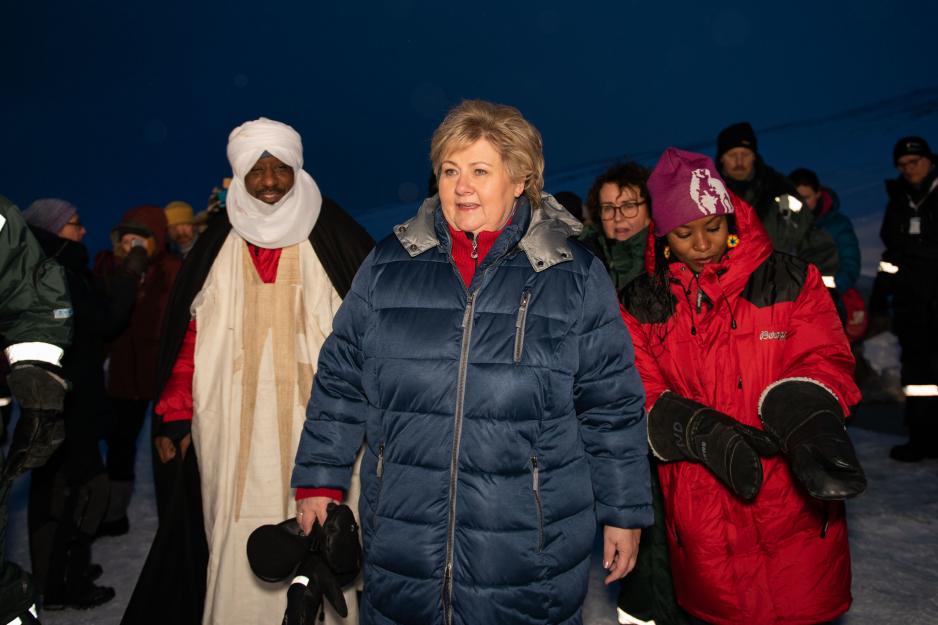In the Middle of an Avalanche Area, the Prime Minister Must Answer Questions About Deceased Artist

Norwegian PM Erna Solberg visited Longyearbyen earlier this week along with a large international delegation. There, she had to answer questions about a deceased artist as well as her Fisheries and Seafood Minister. Photo: Ragnhild Utne/Svalbard Global Seed Vault
Prime Minister Erna Solbeg visited Longyearbyen earlier this week, and the PM herself had requested a visit to the housing area where an avalanche had killed two people in December 2015. Standing at the scene, she had to answer questions about recently deceased Norwegian artist Jahn Teigen and Fisheries Minister Geir Inge Sivertsen. I am ashamed on behalf of journalism.
The backdrop is tragic.
Back in 2015, the people in Longyearbyen were preparing for a peaceful Christmas celebration. There is hardly anything more peaceful on earth that Christmas in Svalbard. In the iconic houses with their peaking roofs, just below Sukkertoppen mountain, life ran its regular course.
The rest is death and chaos
Then the avalanche hit. The rest is death and chaos. But quickly also a heroic effort by the population of Longyearbyen. In a matter of minutes, homes were turned into rubbles and smithereens. Children were dug out using frying pans. It was pitch black dark, cold, and a sinister wind was blowing.
After the incident, two sober press releases from the Svalbard Governor stated that a man and a child died in the avalanche. Nine people were injured, 11 houses smothered. For a long time, the ruins lay at the center of Longyearbyen, a monument to the ravaging power of nature. A brutal memorial over a tragedy that had struck the entire town.
Since then, avalanches have continued. Climate changes have made evacuations a regular part of everyday life for the inhabitants of Longyearbyen. Major parts of Longyearbyen's population have been moving around since then, looking for secure surroundings.
Digging for life
Prime Minister Erna Solberg wanted to see this with her own eyes. She got to see it together with some of the victims, the parents who – in a completely surreal way – found their two little children alive under the enormous amounts of snow, snow that pushed its way into the apartments and moved the houses yards away from their foundations.
I was at the scene myself while the remains of former homes lay crushed on the ground. It left a strong impression, as Arctic accidents always do. The images of the dramatic rescue effort is still glued to my retina. In the light of head lamps, people were literally digging for life.
More than four years later, Erna Solberg packs her suitcase and goes to Longyearbyen. In this way she, too, can assert Norwegian sovereignty, while the objections against Norwegian management of the Svalbard Treaty pour in from Russia.
In her suitcase, one also finds a Fisheries Minister who is clinging to his ministerial post while public support in the form of generous severance pay fills his pockets. it is her responsibility to clean that up. As it is now, Erna Solberg runs the risk that important politics, such as Norway’s role in the Arctic, drown in personnel politics. The Fisheries Minister sets the agenda, far away from the center of events.
The fact that she, like the rest of the Norwegian population, is sad that artist Jahn Teigen died, is fair enough.
The responsibility of the press
And perhaps she should have refused to answer questions about Teigen and Sørensen while she was at the scene of the avalanche.
Nevertheless, the press also carries an independent responsibility for behaving with decency, regardless of what the PM would think. Not everyone who accompanied the PM to Svalbard lived up to that responsibility.
Press ethics fading proportionally to the distance to the press offices is nothing new. But I can hardly imagine that a dramatic crime scene in Oslo would be ignored in the same emotionless way.
This op-ed was originally published in Norwegian and has been translated by HNN's Elisabeth Bergquist.

